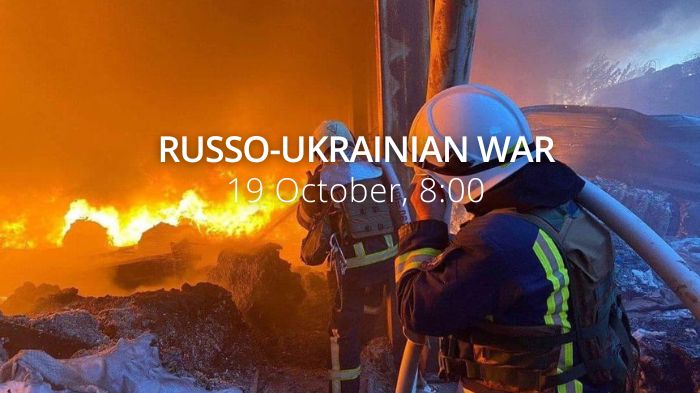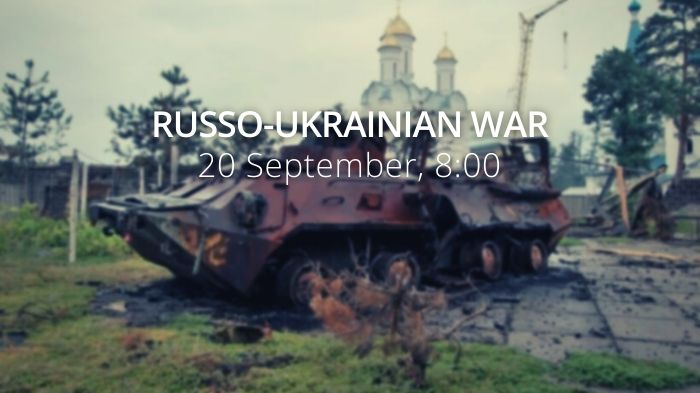Kyiv and its partners will no longer announce the number of weapons Ukraine receives. The Russian Foreign Minister announces that Russia will respond to the supply of Western weapons to Ukraine by seizing new territories. Russian forces resume limited ground attacks in Donbas but fail to seize the Vuhlehirska power plant, Ukraine’s second biggest power plant, 50km northeast of Donetsk. Ukrainian forces conducted the second consecutive high-precision strike against the Antonivskyi Bridge, a major Russian logistics artery east of Kherson City. The Ukrainian military continues to destroy the Russian weapons depots. Russian authorities use Ukrainian high-precision strikes and partisan activity to start mass deportations of Ukrainian citizens to Russia. Ramstein-4: "No fatigue from the war in Ukraine." First Lady of Ukraine speaks in the USCongress. Putin might face another war front as a Chechen battalion prepares a second offensive against the Russian Federation.
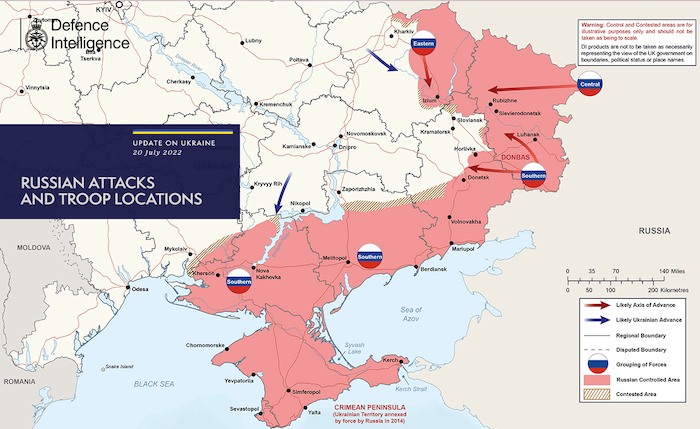
Daily overview — Summary report, July 21
According to military expert Stanislav Haider, as of July 21,
Donetsk Oblast. Ukrainian troops successfully repulsed more Russian assaults on Bohorodychne, Dolyn, and the area of Krasnopilia. Ukrainian-controlled part of the Vugleghirsk power plant and Novoluhanske are holding on despite Russian attacks. Siversk remains under Ukrainian control. Fighting continues at Hryhorivka, Ivano-Dariivka, and Verkhnyokamyanske.
South of Donetsk Oblast. The counterattacks of the Armed Forces of Ukraine continue in the Mariinka area, and there’s some advancement in the direction of Taramchuk. The Russians tried to storm in the direction of Pavlivka-Yehorivka but didn’t succeed and retreated.
Kharkiv Oblast. The “traditional” Russian assaults in the area of Udy and Prudianka no less traditionally failed. Now reinforced, the Balaklia group of Russian forces began to "flex muscles" and tried to attack in the direction of Husarivka but failed.
Zaporizhzhia Oblast. Artillery duels continue in the area of Vasylivka and Polohy. Ukrainian troops managed to advance slightly from Shcherbaky. Yesterday, the Russian forces hit Huliaypole with a “half package” of the Grad multiple rocket launcher - 20 unguided rockets.
Kherson Oblast. Fighting continues in the area of Kyselivka, Inhulets, Visokopillia, and Snihurivka. The Ukrainian HIMARS multiple rocket launchers hit not only warehouses but also help troops to advance a bit. The supplies of the Russians have greatly deteriorated over the past 2 days.
The destruction of a Russian command-observation post is confirmed, as well as 6 more warehouses with ammunition were hit in the areas of Kherson, Beryslav, and Kakhovka. Also, there were Ukrainian surgical strikes on Russian warehouses in Donetsk, Horlivka, and a Russian base struck in Enerhodar.
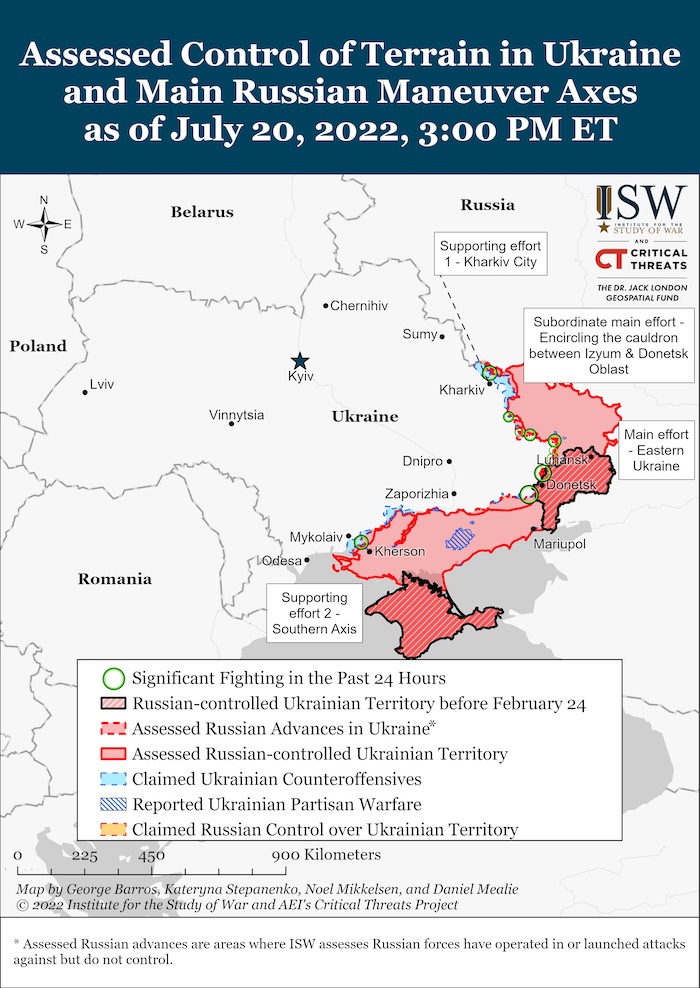
The General Staff’s operational update regarding the Russian invasion as of 06.00 am, July 21, 2022 is in the dropdown menu below.
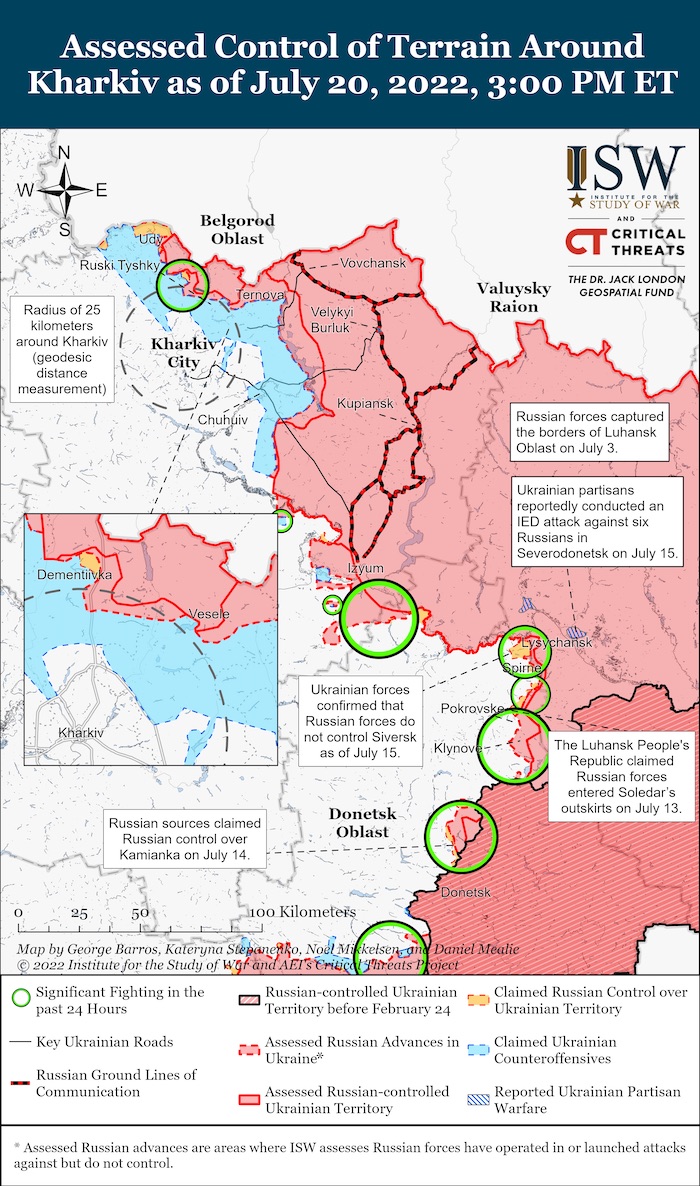
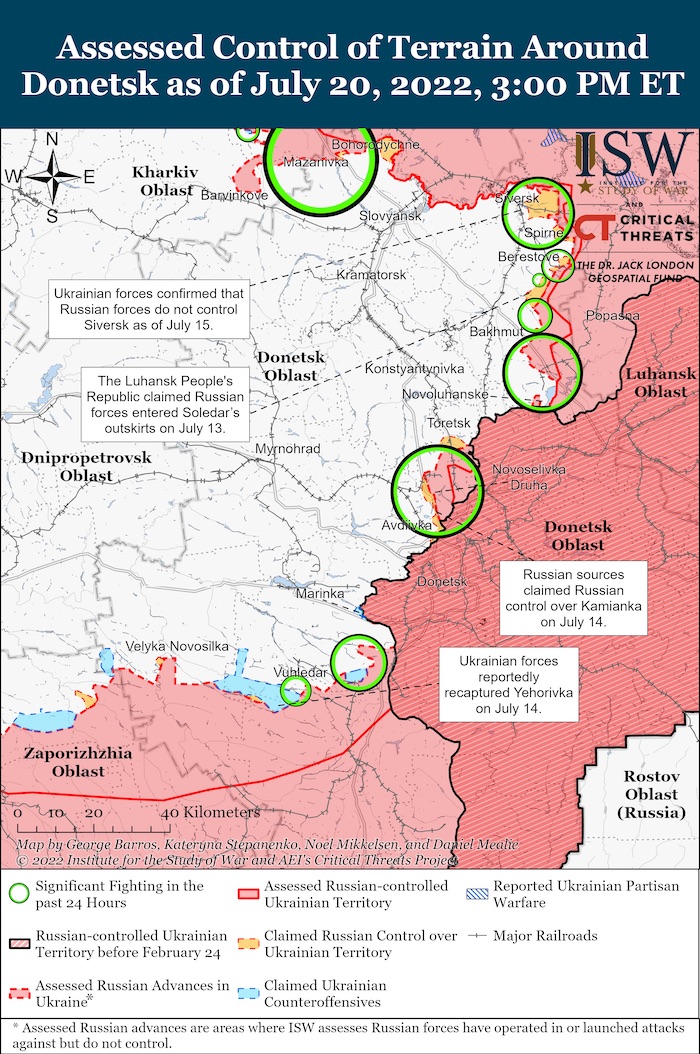
Military Updates
The fourth Ramstein meeting took place in an online format. Oleksii Reznikov, Ukraine Defense Minister, wrote at the Ministry of Defence site:
«The fourth meeting of the Ukraine Defense Contact Group has taken place. This platform in support of Ukraine known as the Ramstein format was established thanks to US leadership and now unites 50 countries from all continents (except for Antarctica).
Together with Deputy Commander-in-Chief of the Ukrainian Armed Forces, Lieutenant General Yevhen Moysyuk, and the Deputy Chief of the Main Intelligence Directorate of the Ministry of Defense, major general Vadym Skybytskyi, we informed the partners of the situation at the front and familiarized them with the current needs of the Ukrainian defense forces. The foregoing line-up of the Ukrainian team in Ramstein has already become traditional.
I am convinced that the partners should see with their own eyes the synergy of the defense department, our military command and intelligence. Unity is the source of our strength and a guarantee of our future victory over the russian invaders.
As agreed with colleagues, we hold the intrigue regarding a lion’s share of existing and upcoming aid packages. These include weapons and ammo, training of our soldiers, and more. At first, the enemy will feel this aid on the battlefield. A positive signal from the meeting is new commitments of the partners concerning land, sea, and sky.
I thanked the USA and personally a close friend of Ukraine and my friend, US Secretary of Defense Lloyd Austin, for his support.
The next aid package from the US to be announced this week includes inter alia 4 M142 HIMARS systems that are already affecting the course of the war.
I would like to note that the American partners and as well as colleagues from other countries expressed their admiration for the skill of our soldiers, including the way they use artillery and HIMARSes.
Among other things, the meeting’s participants were presented with an overview of the results on the battlefield, namely the losses of russian invaders in manpower, equipment, and military capabilities as a whole. These are impressive numbers that prove that Ukraine is indeed the shield of Europe. It is important that this overview was prepared specifically by the partners based on their data and evaluations.
I emphasized three priorities for Ukraine.
- Firstly, it is the strengthening of the mission-oriented approach. We ask the colleagues to concentrate their efforts on increasing the capabilities of the Ukrainian armed forces to carry out certain missions. One of them is unblocking our ports and ensuring safety in the western part of the Black Sea. Everyone saw the first results in the form of liberating Zmiinyi (Snake) Island. The work continues. New “gestures of goodwill” from the invaders are possible.
- Secondly, it is time to systematize the maintenance and repair of foreign equipment supplied to us. It is a large-scale task, and we are already talking about hundreds of units. We need coordination of many countries in the legal, financial and organizational spheres as well as at the level of production capacities.
- Thirdly, we are increasing efforts to ensure transparency in registering and using international military aid. In particular, the implementation process of the NATO LOGFAS program will be accelerated.
I will also point out three things I have heard from colleagues.
- A number of countries directly stated that there was no fatigue from the war in Ukraine and no such thing would happen in the future. There is an understanding that the security of the whole Europe is at stake, not just Ukraine. The whole world sees how our defenders hold the front line over 2 500 km long. It is like the distance between Warsaw to Barcelona. The perception of Ukraine as a shield of Europe in the east is getting clearer. Generally, there is the common position of Ramstein members to support Ukraine until its victory.
- It was numerously emphasized that time is of the essence. I stressed that in my speech. However, this thesis already exists in the agenda of those supporting us. We are doing everything to put all this into practice.
- Many partners are ready to train our soldiers. It is an opportunity to get high-quality reserves that will master western weaponry behind front lines. Also, this will set the stage for increasing the amount of support.
We are working on Ukraine’s victory 24/7.»
Oleksii Reznikov also spoke to the Atlantic Council. Key points:
"The tools to win
- Reznikov praised his military’s ability to inflict serious damage on Russia’s occupying forces in Ukraine, particularly through the long-awaited high-mobility artillery rocket systems (HIMARS) from the United States. “For us, saving the lives of our people is of crucial importance now,” he said. “That’s why we’re using HIMARS systems precisely like the scalpel of a doctor [in] surgery.”
- But while Ukraine has already liberated more than 1,000 towns and settlements previously occupied by Russia, Reznikov said, it still aims to reclaim another 2,500 or so—which is why Kyiv’s forces need “at least 100” more HIMARS and multiple-launch rocket system (MLRS) units to be “a game-changer” during any Ukrainian counteroffensive. “We proved to our partners that we can use these economically, I would say, and precisely.” He added that Ukraine needs 50 more HIMARS just to stop Russia from seizing more territory.
- Reznikov said long-range rockets capable of hitting targets at least 100-150 kilometers away are now needed to “completely destroy” deep-seated Russian supply lines without pounding large swaths of terrain like Moscow currently does through what Reznikov described as its “meat-grinder” strategy. He also emphasized the need for anti-aircraft and anti-missile systems, anti-ship missiles, aircraft, tanks, and armored personnel carriers to mount a successful counteroffensive.
Lessons (to be) learned
- But artillery guns alone aren’t enough, Reznikov said: They should be complemented by “organic units” that include reconnaissance drones to continue effectively targeting Russian forces while minimizing collateral damage.
- More broadly, he believes there’s clear value for Western arms producers to ship their products to Ukraine—whose battlefields have become “a testing ground” for new gear.
- Reznikov cited Poland’s AHS Crab self-propelled howitzer as just one example, adding that his military regularly shares feedback about how the equipment performs in real-life situations against a well-armed enemy. “Give us the tools—we will finish the job [and] you will have new information,” he said in an appeal to arms producers.
Terror has a name
- Another way the West can help, Reznikov says, is by officially designating Moscow as a state sponsor of terrorism based on its indiscriminate attacks on Ukrainian civilians. “The Kremlin needs to be seen as the leader of global terrorism and treated accordingly,” he said. “As a lawyer, I am certain that we have more than enough formal reasons to do so.”
- He appealed to American audiences, specifically, by suggesting there was significance behind what Ukrainian intelligence believes is a Kremlin plan to hold referendums on annexing occupied territory. “The Kremlin associates itself with terrorism even in its choice of symbols,” Reznikov added.
Looming crises
- Since the start of the invasion, Russia’s Black Sea Fleet has blockaded Ukraine’s ports and kept the country’s grain from getting to market, exacerbating a global food crisis. Reznikov voiced support for the idea of a humanitarian convoy—a recent Atlantic Council issue brief delved into this issue—to open the critical port in Odesa, if the operation were to be conducted “under the [United Nations] umbrella” in partnership with NATO ships.
- Reznikov also noted how these impacts of a full-scale war were predictable—and indeed he predicted many of them himself in a December article for the Council’s UkraineAlert section. “I wrote that a large-scale conflict would create three to five million refugees and would pose a threat to global food security. I also noted that Ukraine would fight,” he said. “My predictions came true.”"
Regional Updates
A map of the approximate situation on the ground in Ukraine as of 00:00 UTC 21/07/22.
There have been no notable changes to control since the last update. pic.twitter.com/zfxgjkvXoB
— War Mapper (@War_Mapper) July 21, 2022
In the Donetsk Oblast, Russians shelled Kramatorsk, destroying enterprises and a school. In an attempt to storm Bakhmut, they fired at the central part of the city. 1 killed, 5 inured, and a school destroyed in Kostiantynivka.
In the Luhansk Oblast, the Russian army fired at Bilohorivka from the Grad MLRS.
https://twitter.com/EuromaidanPress/status/1549782181219684352
In the Kharkiv Oblast, Russians shelled Kharkiv, 3 dead, including a 13-year-old boy. A 72-year-old woman was injured.
In the Sumy Oblast, Russian invaders fired at several communities, damaging buildings, and cars, 1 wounded.
In the Dnipropetrovsk Oblast, Russian occupiers fired over 30 rockets at residential areas in Nikopol overnight, 2 dead. Previously, 2 killed, 9 injured. 6 hospitalized, including 4 children. The younger one is only three years old. 3 private houses completely destroyed by shelling, and about a dozen were damaged. Rescuers continue to dismantle the rubble and find out the extent of the destruction. Undetonated ammunition is scattered around the city.
In the Zaporizhzhia Oblast, Russian occupiers plan to store weapons and explosives in the engine rooms of the power units of Europe’s largest nuclear power plant, Zaporizhzhia Nuclear Power Plant, in order to protect their positions from strikes of the Armed Forces of Ukraine, according to Energoatom. The Russian military demand that the administration of the Ukrainian nuclear power plant open machine rooms for them at three power units in order to place their entire military arsenal there. They plan to drive tanks, trucks, weapons with ammunition, etc. into the turbine halls, violating fire safety requirements for nuclear and radiation safety.
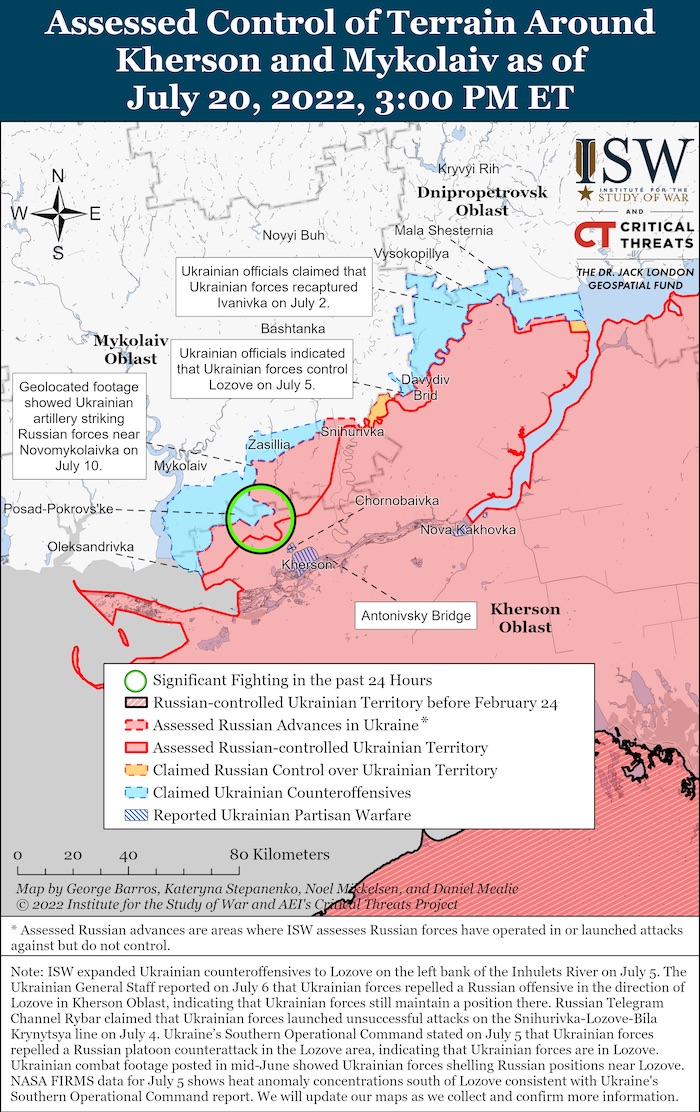
In the Kherson and Mykolaiv Oblasts, the Ukrainian army delivered 10 air strikes at the Russian occupiers, destroying the accumulation of manpower and equipment, and ammunition depots. Ukrainian rocket and artillery units completed over 200 fire missions, eliminating:
- 111 personnel,
- Msta-B howitzer,
- 2 self-propelled artillery and mortar installations “Nona-S”,
- Eleron-type unmanned aerial vehicle,
- 13 units of armored and other vehicles.
- 6 additional ammunition depots.
In the Kherson Oblast, the Ukrainian army attacked and damaged Antonovsky bridge. The bridge is now closed to traffic.
In the Mykolaiv Oblast, shelling continues. Explosions reported in Mykolaiv.
https://twitter.com/EuromaidanPress/status/1549866738682150913
According to British Defence Intelligence, (last 48 hours):
- Russian and separatist forces continue to attempt small-scale assaults along the Donbas front line. Russian forces are likely closing in on Ukraine’s second biggest power plant at Vuhlehirska, 50km north-east of Donetsk.
- Russia is prioritizing the capture of critical national infrastructure, such as power plants. However, it is probably also attempting to break through at Vuhlehirska, as part of its efforts to regain momentum on the southern pincer of its advance towards the key cities of Kramatorsk and Sloviansk.
Losses of the Russian army
As of 21 July, the approximate losses of weapons and military equipment of the Russian Armed Forces from the beginning of the war to the present day:
⚰️russia's combat losses in Ukraine as of July 21
▪ 38850 killed soldiers (+100)
▪ 3912 APV (+7)
▪ 1704 tanks (+4)
▪ 859 artillery systems (+8)
▪ 221 aircraft and 188 helicopters
▪ 15 boats and cutters #StopRussia #StandWithUkraine pic.twitter.com/oIX8Z3grgq— VoxUkraine (@voxukraine) July 21, 2022
Humanitarian
The UK allows Ukrainian children to enter unaccompanied by parents but only if one of his parents or guardian confirms that it is in the best interests of the child. In addition, UK citizens hosting a child from Ukraine must commit to at least a 3 years term (instead of 6 months in the case of adults) or until the child is 18 years old.
️️Environmental
The export of Ukrainian grain will be carried out through three Ukrainian ports (Odesa, Yuzhny and Chornomorsk) and controlled by a group under the supervision of the UN. According to the agreed safe routes, all civilian ships will be able to enter the ports of Ukraine.
Legal
Support
Ukraine will receive a record tranche of $4.5 billion in non-repayable aid. The Cabinet approved a $4.5 billion grant from the International Bank for Reconstruction and Development and the International Development Association. Non-repayable support will be used to finance the project “Public Expenditure Support for Sustainable Public Administration in Ukraine”.
USAID announced $100 million in support for Ukrainian farmers. The initiative is created to strengthen the agricultural sector in the face of Putin’s destruction and will help Ukraine solve export problems and maintain food production.
Only the US sanctioned all top managers of Russian defense corporation Rostech.
8 out of 9 did not fall under the sanctions of the EU, UK & Ukraine. They sanctioned only CEO Sergey Chemezov, who is close Putin's friend since their work in eastern Germany https://t.co/zfPhPRP9rh
— Euromaidan Press (@EuromaidanPress) July 20, 2022
️The EU approved the 7th package of sanctions against the Russian Federation, including a ban on the supply of gold.
Member States have agreed to our reinforced, prolonged EU sanctions against the Kremlin.
I welcome that.
It sends a strong signal to Moscow: we will keep the pressure high for as long as it takes. https://t.co/eO87bSmGR1
— Ursula von der Leyen (@vonderleyen) July 21, 2022
The US Secretary of Defense Lloyd Austin said that in the coming days, Washington will allocate 4 HIMARS MLRS to Ukraine.
The US will provide 4 additional rocket launchers to Ukraine as part of a forthcoming package of military assistance, Defense Secretary Lloyd Austin said.
Once delivered, the US will have sent a total of 16 HIMARS to Ukraine. https://t.co/CSL99aDkkH
— Euromaidan Press (@EuromaidanPress) July 20, 2022
Germany will provide Ukraine with 20 Leopard-2 tanks by 2023, according to the Member of the Bundestag. Delivery will start in April 2023, 1 tank per month, from October 2023–3 tanks per month. Poland handed over almost 300 T-72 tanks to Ukraine in the first 2 months.
Lithuania will provide Ukraine M113 & M577 APCs
Minister of National Defense Arvydas Anušauskas announced this on July 20, adding that due to the given or promised number of M113, this armored vehicle becomes a significant part of the Ukrainian army https://t.co/pIsuWmEUvh pic.twitter.com/AxApIsWXBY
— Euromaidan Press (@EuromaidanPress) July 20, 2022
Lithuania is going to transfer additional M113 and M577 armored personnel carriers, as well as ammunition to Ukraine.
Rolls-Royce will rebuild hospital destroyed by Russians in Sumy region in March. Part of the money for the restoration will be transferred by the company, and the rest of the funds were collected directly by Rolls-Royce employees. In general, the restoration of the outpatient clinic will cost UAH 13 million. The medical facility is expected to open in six months.
New Developments
Ukrainian first lady Olena Zelenska appealed for more weapons against Russia’s terror, speaking at US Congress.
“Weapons that would not be used to wage war on somebody else’s land but to protect one’s home&the right to wake up alive in that home” she saidhttps://t.co/rN8yFyANMZ pic.twitter.com/FAJZvoWmRx
— Euromaidan Press (@EuromaidanPress) July 20, 2022
Assessment
On the war.
The Institute for the Study of War has made the following assessment as of 19 July, 2022:
The current Russian offensive may secure limited additional territorial gains in Donbas northeast of the E40 highway but will likely culminate before seizing major populated areas such as Sloviansk or Bakhmut. Russian forces have not made significant advances towards Sloviansk or along the Siversk-Bakhmut salient in the past few weeks and are continuing to degrade their own offensive combat power in localized fights for small and relatively unimportant settlements throughout Donetsk Oblast. Russian troops have notably been attempting to take Siversk since the capture of Lysychansk and the Luhansk Oblast border on July 3 and have still not reached the city as of July 20.[1] Similarly, Russian troops have failed to launch direct assaults on Bakhmut and have largely impaled themselves on fights for small settlements to its east and south. Efforts to advance on Sloviansk have mostly ground to a halt and have made no meaningful gains for weeks. The renewal of active ground offensives following the brief operational pause has not yet translated into meaningful Russian forward progress, although it is possible that either steady Russian pressure or the completion of Russian efforts to rebuild combat power could generate limited gains in the coming days or weeks.
[Map showing population density in Donbas as of 2020 in comparison with ISW’s assessed control of terrain in Donetsk Oblast as of July 20, 2022. Russian forces will likely face challenges taking control of the darker-grey areas, which represent more densely-populated hromadas and are largely concentrated along the E40 highway between Sloviansk and Bakhmut]
Russian troops are now struggling to move across relatively sparsely-settled and open terrain. They will encounter terrain much more conducive to the Ukrainian defenders the closer they get to the E40 around Sloviansk and Bakhmut due to the increasing population density and built-up nature of these areas (see map in-line with text). The current Russian offensive in Donbas is therefore highly likely to culminate somewhere along the E40 in the coming weeks.
Russian Foreign Minister Sergey Lavrov articulated expanded geographical aims for Russian operations in Ukraine on July 20, confirming ISW’s long-held assessment that Russia has territorial goals beyond Donetsk and Luhansk Oblasts. Lavrov held an interview with state-owned media outlet RT’s editor-in-chief Margarita Simonyan wherein he stated that the geography of the “special operation” has changed since March and now includes not just the Luhansk and Donetsk People’s Republics, but also Kherson and Zaporizhzhia Oblasts and a number of other unspecified territories.[2] Lavrov also warned that these goals will expand if the West continues to provide Ukraine with long-range weapons. Lavrov’s calls for maximalist territorial objectives are notably divorced from the slow and grinding reality of recent Russian operations in Ukraine as discussed above. Ukrainian counteroffensive pressure is complicating Russian efforts to consolidate military control of occupied Kherson and Zaporizhzhia Oblasts, and it is unclear how the Kremlin will generate the offensive combat power needed to take significant new amounts of Ukrainian territory.
The Russian Defense Ministry publicly identified Lieutenant General Andrey Sychevoy as the commander of the Western force grouping in Ukraine on July 20.[3] The Russian force groupings in Ukraine appear to follow the structure of established Russian military districts. Ukraine’s Conflict Intelligence Team (CIT) had previously reported that Sychevoy replaced Commander Alexander Zhuravlev as the Western Military District Commander.[4] Russian Defense Minister Sergey Shoigu instructed Sychevoy to focus on destroying Ukrainian UAVs operating near the Ukraine-Russia border, indicating that the Western force grouping is likely operating on the Kharkiv City Axis.[5] Russian forces have thus apparently split Kharkiv Oblast into two axes: the Western force grouping operating towards Kharkiv City and the Eastern force grouping operating in the Izium-Sloviansk direction.[6]
The Russians have identified commanders of the southern, central, and eastern groups of forces, corresponding to their respective military districts and oriented on Bakhmut, the Izium area, and Siversk respectively. They have notably failed to identify any commander of Russian forces operating in occupied southern Ukraine, however. The Russian commander of forces on the Southern Axis could be the commander of the Russian 7th Guards Mountain Airborne (VDV) Division based in Novorossiysk, Krasnodar Krai, or of the Black Sea Fleet’s 22nd Army Corps, based in Simferopol, Crimea, respectively, as there is no other obvious military district from which he might be drawn.[7]
Ukrainian troops rescued a cat during clearing operations on Zmiinyi (Snake) Island and evacuated it back to the Ukrainian mainland on July 20.[8] The cat reportedly survived the duration of the Russian occupation of the island.
Key Takeaways
- The current Russian offensive will likely make marginal territorial gains northeast of the E40 highway in Donetsk before culminating along the E40.
- Russian Foreign Minister Sergey Lavrov said that Russia is pursuing expanded territorial gains in Ukraine beyond Luhansk and Donetsk Oblast, confirming ISW’s assessment that the Kremlin seeks to capture territory beyond Donbas.
- Russian forces resumed limited ground attacks northwest of Sloviansk and around the Donetsk City-Avdiivka area.
- Russian forces continued localized ground assaults east of Siversk and made marginal gains northeast of Bakhmut.
- Ukrainian forces conducted the second consecutive high-precision strike against the Antonivskyi Bridge-- a major Russian logistics artery east of Kherson City.
- Russian occupation authorities are likely propagandizing recent Ukrainian high-precision strikes and partisan activity to set conditions for mass deportations of Ukrainian citizens to Russian territory.


